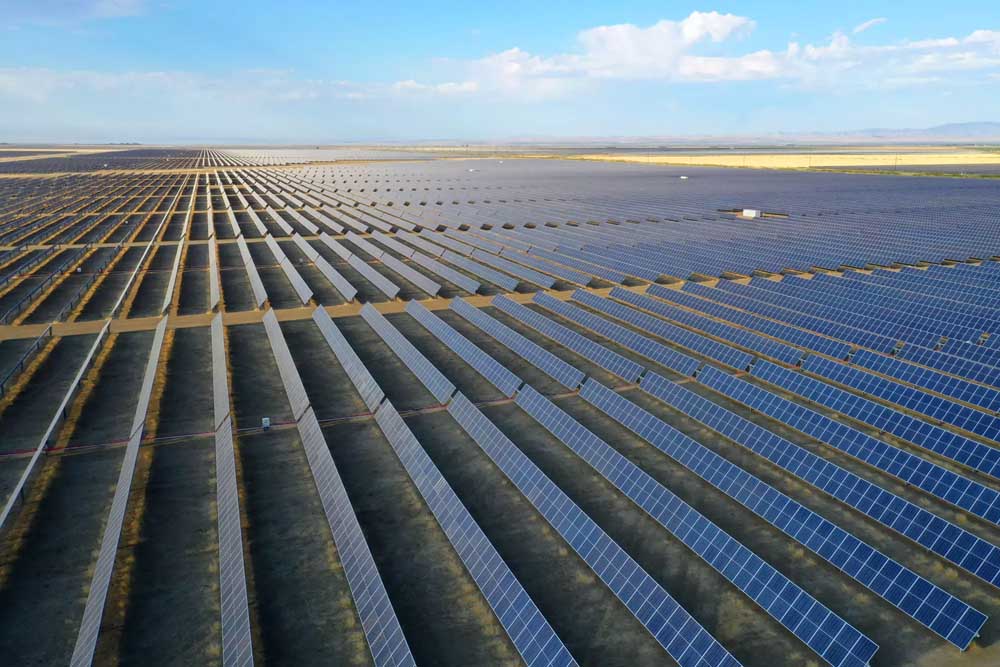Solar power glut boosts California electric bills. Other states reap the benefits
Published 2:33 pm Monday, December 2, 2024

- Westlands Solar Park, near the town of Lemoore in the San Joaquin Valley.
California is making so much solar energy that large commercial operators are increasingly forced to stop production, raising questions about the state’s costly plan to shift entirely to carbon-free sources of electricity.
In the last 12 months, California’s solar farms have curtailed production of more than 3 million megawatt hours of solar energy, either on the orders of the state’s grid operator or because prices had plummeted because of the glut, according to an analysis of data by The Times.
That’s enough to power 518,000 California homes for a year, based on average electricity usage.
The amount of curtailed solar power has more than doubled from 1.5 million megawatt hours in 2021, state records show, and is up eight times from levels in 2017.
The waste would have been even larger if California had not paid utilities in other states to take the excess solar energy, documents from the state’s grid operator show. That means green energy paid for by California electricity customers is sent away, lowering bills for residents of other states.
Arizona’s largest public utility reaped $69 million in savings last year by buying from the market California created to get rid of its excess solar power. The utility returned that money to its customers as a credit on their bills.
Also reaping profits are electricity traders, including banks and hedge funds.
The increasing oversupply of solar power has created a situation where energy traders can buy the excess at prices so low they become negative, said energy consultant Gary Ackerman, the former executive director of the Western Power Trading Forum. That means the solar plant is paying the traders to take it.
“This is all being underwritten by California ratepayers,” Ackerman said.
California grid officials warned in 2017 that the curtailments were a sign that the state was overbuilding renewables and “not financially sound.”
Since then the problem has grown exponentially.
Solar is the linchpin of California’s plan to generate all its electricity from carbon-free sources by 2045, but some energy experts question the feasibility of the plan given the state’s inability to use its existing solar capacity.
On some days, more than half the available solar power goes to waste, said Phillippe Phanivong of the California Institute for Energy and Environment located at UC Berkeley.
He calculates that the amount of power curtailed increased by 500% between 2017 and 2022 — a rise he called “alarming.” During that same time, the state’s renewable energy generation increased by 40%.
“Can we even get to 100% renewable energy with this growth rate of curtailment?” Phanivong asked.
The solar glut also means higher electricity bills for Californians, since they are effectively paying to generate the power but not using it.
California’s electric rates are roughly twice the nation’s average, with only Hawaii having higher rates.
“Ratepayers aren’t getting the energy they’ve paid for,” said Ron Miller, an energy industry consultant in Denver. He calculates that the retail value of the solar energy thrown away in a year would be more than $1 billion.
Gov. Gavin Newsom’s advisors and those who manage the state’s electric grid say they are working to reduce the curtailments, including by building more industrial-scale battery storage facilities that soak up the excess solar power during the day and then release it at night.
Officials in the governor’s office declined to be interviewed, but issued a statement saying the curtailments are often because of congestion on transmission lines, rather than a statewide oversupply of power. The state has been spending heavily to upgrade transmission lines to ease the congestion.
“It’s also important to have extra energy resources available that can help the state during periods of extreme weather and historic heatwaves when demand is particularly high, which have happened the past few years,” the statement said.
Homes with rooftop solar have increased the curtailments at the industrial solar farms by decreasing electric demand, said Guillermo Bautista-Alderete, an official with the California Independent System Operator, which runs the state’s power grid.
Grid operators must match the amount of power being produced to demand to prevent the grid from overloading, he said.
Economics upended
California already produces more solar than any other state. Newsom administration officials say the state must triple the rate of the construction of industrial-scale solar installations over the next two decades to get to a carbon-free electrical grid by 2045.
To create incentives for companies to build that much solar power, a 2018 law known as Senate Bill 100 requires utilities and locally run electricity providers to purchase an increasing amount of renewable energy, which then becomes part of the electrical mix delivered to customers.
By 2030, 60% of the state’s electricity must be from renewable sources.
The state’s utilities buy most of that energy in advance at a fixed price set by long-term contracts negotiated with the solar farms and other renewable energy producers.
Eddy at the solar association said these contracts protect ratepayers from price hikes during times of high demand. But the contracts can also require electric customers to pay the fixed prices even if they must stop producing because the state has too much electricity.
The Los Angeles Department of Water and Power says that many of its contracts contain such terms.
“Curtailed energy is energy that has already been paid for but cannot be used,” LADWP explained in its 2022 strategic plan, which emphasized it was trying to minimize the curtailments.
To stop the solar farms from sending energy to the grid, the grid operator, a nonprofit known as CAISO, sometimes calls the operator and orders it to shut down, Bautista-Alderete said.
More frequently, however, the software that operates CAISO’s electricity market automatically sends prices plummeting when too much energy is flowing onto the grid, he said. The operator then decides to shut down to avoid losing money.
In the last two years, experts say, a strange thing has happened. When prices fall to $0 on the market, the solar farms keep producing. Some keep generating even when prices plummet to deeply negative prices, where they then have to pay heavily to put their power on the grid.
Ackerman said energy producers are willing to pay to put their power on the grid because they are making money elsewhere.
Among solar farms’ revenues are federal tax credits. Miller, the energy industry consultant, estimated that federal taxpayers paid $54 million to subsidize the 2.6 million megawatt hours that California curtailed in the 12 months ending in October 2023.
An even bigger source of revenue for solar farms is the so-called renewable energy credit, or REC, Ackerman and others say.
Producers of renewable energy get one REC for each megawatt hour they put on the grid. Companies buy the RECs, allowing them to take credit for the environmental benefits of that megawatt hour of solar. A utility or an airline can buy the RECs and then say it burned less fossil fuels than it actually consumed, a practice some criticize as greenwashing.
As California and other states have required utilities to buy more renewable power, demand for the RECs has skyrocketed. So has their price, from $15 to $75 a megawatt-hour in the last two years, experts say.
“All of a sudden there was a huge demand” for the credits, Ackerman said.
That means a solar farm can still earn a profit even when prices are deeply negative. Last year, prices plunged to negative $145 per megawatt-hour or below as the sun was shining, CAISO said in a recent report.
Then the sun sets. And power prices can spike to $50, $100 or far more.
This volatility is a gold mine for electricity traders.
“Any fluctuation, any variation, they’re making money off that,” Chien said.








